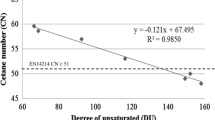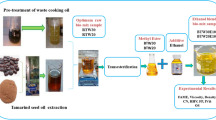Abstract
Physical and chemical properties of biodiesel are influenced by the structural features of fatty acid, such as with saturated, monounsaturated and polyunsaturated fatty acids. In this study, seven non-edible oils have been selected, which include waste cooking oil derived palm olein, Calophyllum inophyllum, jatropha oil, castor oil, rubber seed oil, kapok seed oil and karanja oil. The critical parameters, e.g. cetane number (CN), iodine value (IV) and oxidation stability (OS) of biodiesel were correlated with the degree of unsaturated (DU) fatty acid, whereas the cold filter plugging point (CFPP) was correlated with the long chain saturated factor (LCSF). To meet the minimum EU requirement of EN 14214 of the critical parameter, the DU value of the CN was ≤133.5, IV ≤123.2 and OS ≤98.9. The LCSF values satisfied the Spanish regional standard—RD 61/2006 in summer (0 °C) at ≤8.4 and winter (−10 °C) at ≤0.1 of the CFPP. Based on the composition of the saturated, monounsaturated and polyunsaturated fatty acids, a triangular chart for the biodiesel property prediction was developed. This can then be used as a reference for non-edible oils.





Similar content being viewed by others
References
Abbasi S, Diwekar UM (2014) Characterization and stochastic modeling of uncertainties in the biodiesel production. Clean Technol Environ Policy 16:79–94
Abedin MJ, Masjuki HH, Kalam MA, Sanjid A, Rahman SMA (2014) Performance, emissions, and heat losses of palm and jatropha biodiesel blends in a diesel engine. Ind Crop Prod 59:96–104
Altun S (2014) Effect of the degree of unsaturation of biodiesel fuels on the exhaust emissions of a diesel power generator. Fuel 117:450–457
Atabani AE, Silitonga AS, Ong HC, Mahlia TMI, Masjuki HH, Badruddin IA, Fayaz H (2013) Non-edible vegetable oils: a critical evaluation of oil extraction, fatty acid compositions, biodiesel production, characteristics, engine performance and emissions production. Renew Sust Energy Rev 18:211–245
Atabani AE, Silitonga AS, Badruddin IA, Mahlia TMI, Masjuki HH, Mekhilef S (2012) A comprehensive review on biodiesel as an alternative energy resource and its characteristics. Renew Sust Energy Rev 16:2070–2093
Bajpai D, Tyagi VK (2006) Biodiesel: source, production, composition, properties and its benefits. J Oleo Sci 55:487–502
Banković-Ilić IB, Stamenkovic OS, Veljkovic VB (2012) Biodiesel production from non-edible plant oils. Renew Sust Energy Rev 16:3621–3647
Banković-Ilić IB, Stojković IJ, Stamenković OS, Veljkovic VB, Hung YT (2014) Waste animal fats as feedstocks for biodiesel production. Renew Sust Energy Rev 32:238–254
Belewu MA, Adekola FA, Adebayo GB, Ameen OM, Muhammad NO, Olaniyan AM, Adekola OF, Musa AK (2010) Physico-chemical characteristic of oil and biodiesel from Nigerian and Indian, Jatropha curcas seeds. Int J Biol Chem Sci 4(2):524–529
Brondani M, Hoffmann R, Mayer FD, Kleinert JS (2015) Environment and energy analysis of biodiesel production in Rio Grande do Sul, Brazil. Clean Technol Environ Policy 17:129–143
Bulatov I, Klemeš JJ (2011) Clean fuel technologies and clean and reliable energy: a summary. Clean Technol Environ Policy 13:543–546
Chhetri AB, Watts KC, Islam MR (2008) Waste cooking oil as an alternate feedstock for biodiesel production. Energies 1:3–18
Cho YJ, Kim TE, Gil B (2013) Correlation between refractive index of vegetable oils measured with surface plasmon resonance and acid values determined with the AOCS official method. LWT 53(2):517–521
Chuah LF, Abd Aziz AR, Yusup S, Bokhari A, Klemeš JJ, Abdullah MZ (2015a) Performance and emission of diesel engine fuelled by waste cooking oil methyl ester derived from palm olein using hydrodynamic cavitation. Clean Technol Environ Policy. doi:10.1007/s10098-015-0957-2
Chuah LF, Yusup S, Abd Aziz AR, Bokhari A, Abdullah MZ (2015b) Cleaner production of methyl ester using waste cooking oil derived from palm olein using a hydrodynamic cavitation reactor. J Clean Prod. doi:10.1016/j.jclepro.2015.06.112
Chuah LF, Yusup S, Abd Aziz AR, Bokhari A, Klemeš JJ, Abdullah MZ (2015c) Intensification of biodiesel synthesis from waste cooking oil (Palm Olein) in a hydrodynamic cavitation reactor: effect of operating parameters on methyl ester conversion. Chem Eng Process 95:235–240
Cvengros J, Cvengrosova Z (2004) Used frying oils and fats and their utilization in the production of methyl esters of higher fatty acids. Biomass Bioenergy 27:173–181
Delavari A, Halek F, Amini M (2015) Continuous biodiesel production in a helicoidal reactor using ultrasound-assisted transesterification reaction of waste cooking oil. Clean Technol Environ Policy 17:273–279
Dermibas A (2005) Biodiesel production from vegetable oils via catalytic and non-catalytic supercritical methanol transesterification methods. Prog Energy Combust Sci 31:466–487
Dmytryshyn SL, Dalai AK, Chaudhari ST, Mishra HK, Reaney MJ (2004) Synthesis and characterization of vegetable oil derived esters: evaluation for their diesel additive properties. Bioresour Technol 92:55–64
Dwivedi G, Sharma MP (2015) Application of Box-Behnken design in optimization of biodiesel yield from Pongamia oil and its stability analysis. Fuel 145:256–262
Fernandes AMAP, Eberlin MN, Silva PRM, Silva SR, Cunha VS, Daroda RJ, Alberici RM (2014) Unsaturation levels in biodiesel via easy ambient sonic-spray ionization mass spectrometry. Fuel 128:99–103
Ghayal D, Pandit AB, Rathod VK (2013) Optimization of biodiesel production in a hydrodynamic cavitation reactor using used frying oil. Ultrason Sonochem 20:322–328
Ghobadian B, Rahimi H, Nikbakht AM, Najafi G, Yusaf TF (2009) Diesel engine performance and exhaust emission analysis using waste cooking biodiesel fuel with an artificial neutral network. Renew Energy 34:976–982
Gopal KN, Pal A, Sharma S, Samanchi C, Sathyanarayanan K, Elango T (2014) Investigation of emission and combustion characteristics of a CI engine fueled with waste cooking oil methyl ester and diesel blends. Alex Eng J 53:281–287
Islam MA, Ayoko GA, Brown R, Stuart D, Heimann K (2013) Influence of fatty acid structure on fuel properties of algae derived biodiesel. Procedia Eng 56:591–596
Jain S, Sharma MP (2014) Effect of metal contents on oxidation stability of biodiesel/diesel blends. Fuel 116:14–18
Jesikha M (2012) Fatty acid methyl esters characteristic and esterification of some vegerable oils for production of biodiesel. Res Inventy 1(12):50–53
Kalam MA, Masjuki HH, Jayed MH, Liaquat AM (2011) Emission and performance characteristics of an indirect ignition diesel engine fuelled with waste cooking oil. Energy 36:397–402
Knothe G (2006) Analyzing biodiesel: standards and other methods. J Am Oil Chem Soc 83:823–833
Kulkarni MG, Dalai AK (2006) Waste cooking oil an economical source for biodiesel: a review. Ind Eng Chem Res 45:2901–2913
Lam HL, Varbonov P, Klemeš JJ (2010) Minimising carbon footprint of regional biomass supply chains. Resour Conserv Recycl 54:303–309
Lopes JCS, Boros L, Krahenbuhl MA, Meirelles AJA, Daridon JL, Pauly J, Marrucho IM, Coutinho JAP (2008) Prediction of cloud points of biodiesel. Energy Fuels 22:747–752
Lown AL, Peereboom L, Mueller SA, Anderson JE, Miller DJ, Lira CT (2014) Cold flow properties for blends of biofuels with diesel and jet fuels. Fuel 117:544–551
Maddikeri GL, Pandit AB, Gogate PR (2012) Intensification approaches for biodiesel synthesis from waste cooking oil: a review. Ind Eng Chem Res 51(45):14610–14628
Meng X, Chen G, Wang Y (2008) Biodiesel production from waste cooking oil via alkali catalyst and its engine test. Fuel Process Technol 89:851–857
Moser BR (2014) Impact of fatty ester composition on low temperature properties of biodiesel–petroleum diesel blends. Fuel 115:500–506
Na-Ranong D, Kitchaiya P (2014) Precipitation above cloud point in palm oil based biodiesel during production and storage. Fuel 122:287–298
O’Connell D, Savelski M, Stewart Slater C (2013) Life cycle assessment of dewatering routes for algae derived biodiesel processes. Clean Technol Environ Policy 15:567–577
Ong HC, Masjuki HH, Mahila TMI, Silitonga AS, Chong WT, Leong KY (2014) Optimization of biodiesel production and engine performance from high free fatty acid Calophyllum inophyllum oil in CI diesel engine. Energy Convers Manag 81:30–40
Pullen J, Saeed K (2014) Experimental study of the factors affecting the oxidation stability of biodiesel FAME fuels. Fuel Process Technol 125:223–235
Ramos MJ, Fernandez CM, Casas A, Rodriguez L, Perez A (2009) Influence of fatty acid composition of raw materials on biodiesel properties. Bioresour Technol 100:261–268
Rashid U, Knothe G, Yunus R, Evangelista RL (2014) Kapok oil methyl esters. Biomass Bioenergy 66:419–425
Rawat DS, Joshi G, Lamba BY, Tiwari AK, Mallick S (2014) Impact of additives on storage stability of Karanja (Pongamia Pinnata) biodiesel blends with conventional diesel sold at retail outlets. Fuel 120:30–37
Rocha EGdA, Follegatti-Romero LA, Duvoisin S Jr, Aznar M (2014) Liquid–liquid equilibria for ternary systems containing ethylic palm oil biodiesel + ethanol + glycerol/water: experimental data at 298.15 K and 323.15 K and thermodynamic modelling. Fuel 128:356–365
Sanjid A, Masjuki HH, Kalam MA, Ashrafur Rahman SM, Abedin MJ, Palash SM (2013) Impact of palm, mustard, waste cooking oil and Calophyllum inophyllum biofuels on performance and emission of CI engine. Renew Sustain Energy Rev 27:664–682
Singh D, Ganesh A, Mahajani S (2015) Heterogeneous catalysis for biodiesel synthesis and valorization of glycerol. Clean Technol Environ Policy 17:1103–1110
Sivaramakrishnan K, Ravikumar P (2012) Determination of cetane number of biodiesel and it’s influence on physical properties. J Eng Appl Sci 7(2):205–211
Tan K, Lee K, Mohamed A (2011) Potential of waste palm cooking oil for catalyst-free biodiesel production. Energy 36:2085–2088
Toscano G, Riva G, Pedretti EF, Duca D (2012) Vegetable oil and fat viscosity forecast models based on iodine number and saponification number. Biomass Bioenergy 46:511–516
Umaru M, Aberuagba F (2012) Characteristics of a typical Nigerian Jatropha curcas oil Seeds for biodiesel production. Res J Chem Sci 2(10):7–12
Wang LB, Yu HY, He XH, Liu RY (2012) Influence of fatty acid composition of woody biodiesel plants on the fuel properties. J Fuel Chem Technol 40(4):397–404
Wendy Ng PQ, Lam HL, Varbanov PS, Klemeš JJ (2014) Waste-to-energy (WTE) network synthesis for municipal solid waste (MSW). Energy Convers Manag 85:866–874
Yaakob Z, Mohammad M, Alherbawi M, Alam Z (2013) Overview of the production of biodiesel from waste cooking oil. Renew Sust Energy Rev 18:184–193
Acknowledgments
The authors would like to thank the Universiti Teknologi PETRONAS for the Tuition Fee Assistantship (TFA) Scheme, Public Service Department of Malaysia, Marine Department Malaysia, MyRA Grant (No. 0153AB-J19) and Hungarian Project TÁMOP-4.2.2.B-15/1/KONV-2015-0004 “A Pannon Egyetem tudományos műhelyeinek támogatása”.
Author information
Authors and Affiliations
Corresponding author
Rights and permissions
About this article
Cite this article
Chuah, L.F., Yusup, S., Aziz, A.R.A. et al. Influence of fatty acids content in non-edible oil for biodiesel properties. Clean Techn Environ Policy 18, 473–482 (2016). https://doi.org/10.1007/s10098-015-1022-x
Received:
Accepted:
Published:
Issue Date:
DOI: https://doi.org/10.1007/s10098-015-1022-x




